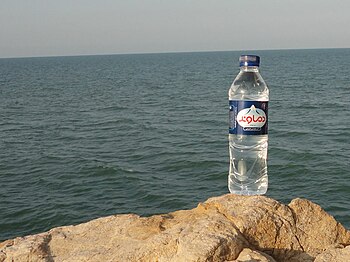 |
| English: Damavand Mineral Water bottle (Photo credit: Wikipedia) |
I have 3 daughters, 11 years, 10 years and 7 years old angels, and currently all studying in the same primary school in Singapore. My eldest being the oldest, and having studied the most of the three (Primary 6, Primary 4 and Primary 2), she freely told my wife on what she knew about the reuse of plastic bottle containers.
We have about 6 different bottled-water containers, all of which are the handy PET bottles, easily filled up, easily carried, easily stored in the fridge, easily emptied, easily cleaned, easily dried, and then again to be refilled and reused the next round.
While we were in the kitchen, she saw (not that the other two don’t see it) my wife drinking from one of the reused water bottles, and she immediately told her of the supposedly “dangers and hazards” of drinking from reused plastic water bottles. And just like any other schoolgirl, everything she said (and consequently, everything she knew about plastic bottles) was all according to her teacher.
Her mother replied that it is safe, so long as you clean the bottles well before each reuse. Then she asked, ‘who told you that?’
‘My school teacher,’ was the reply.
Although I myself knew and have read in the internet before about the mendacity of the claim, that there is leaching of toxins, and plastic bottles should be crushed after the first use, I wanted to search one more time, so I can show to my children, not just my firstborn, about the untruthfulness of the “urban legend”, the hoax, about the “unsafe reuse of plastic bottles”.
Obviously, it is not only water that is contained in plastic bottles, but a lot of other commodities.
Before going into the websites, I actually have some questions, if really the claim of an unsafe reuse is true:
1. The shelf life of the consumables, until how long can they be stored, and at what kind of environment?
2. If the toxins are released when they are reused, what is the certainty that the plastic bottles don’t leach the toxins while they are in storage (first time use)?
3. Is this not simply a marketing hype, so people will “crush and dispose”, then “buy more bottled products”?
4. How do we handle the environmental damage, since the recommendation is to “crush and dispose of”?
5. If plastic bottle containers are unsafe, how about all the other containers and household items that are made of plastic? Can they be deemed safe, or are they also “unsafe and hazardous”?
----------
Body cleansing the natural way...
----------
Just a few questions from me, and not wanting to wax any longer, here goes.
All about plastic information sites:
The Safety of Plastic Beverage Bottles. If not answering all of the questions, this site already has most of the information that a reader would want to know. A very good site indeed.
Note safe, eh? County wants residents to refill plastic bottles.
Not to digress, but this site is all about drinking mineral water
The Truth About Drinking Mineral Water
The environmental damage of plastic:
Series of blunders turned the plastic bag into global villain
The admonition to reuse and recycle
The “myth” links:
Plastic Drink Bottle Cancer Link "a Myth"
Bottle Bunk
Bottle Royale
Plastic drink bottle cancer link 'a myth'
Is it safe to refill single-use water bottles?
Don't Drink Bottled Water Kept in Car
Myths & Realities
Comments for “Why You Must Never Reuse Your Plastic Water Bottles”
Does Freezing Water in Plastic Bottles Release Dioxins?
How widely used is plastic? See below sites for some idea.
The different plastic container/bottle products
Plastic Tanks, Buckets, Labwares, etc.
Container & Packaging Supply
Plastic bottles for commercial use in high-temperature sterilization.
Some developments, but I haven’t seen the conclusion of which.
Planet Green Bottle Corp. Introduces World's First Commercial Oxo-Biodegradable Plastic Bottle
As said in the site itself, Plastic bottles release ‘gender bending’ chemicals. Check it as well.










No comments:
Post a Comment